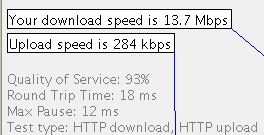 The graphic on the left is from a Vonage test of the connection at a friend’s house near Boston. Comcast cable is her provider. The test was on her computer, which is connected directly to the cable modem. I thought that test result was exceedingly lopsided and Old Skool in respect to upstream performance, so I conducted a different test on the same connection with the same computer. The result: 11958Kbps down and 358Kbps up.
The graphic on the left is from a Vonage test of the connection at a friend’s house near Boston. Comcast cable is her provider. The test was on her computer, which is connected directly to the cable modem. I thought that test result was exceedingly lopsided and Old Skool in respect to upstream performance, so I conducted a different test on the same connection with the same computer. The result: 11958Kbps down and 358Kbps up.
Comcast can do better than that. I suspect the only reason they’re not is because they’d need to “bind” some number of channels that would otherwise carry television. Whatever’s going on, it’s clear that the Net is just gravy on TV. Feh.
Leave a Reply